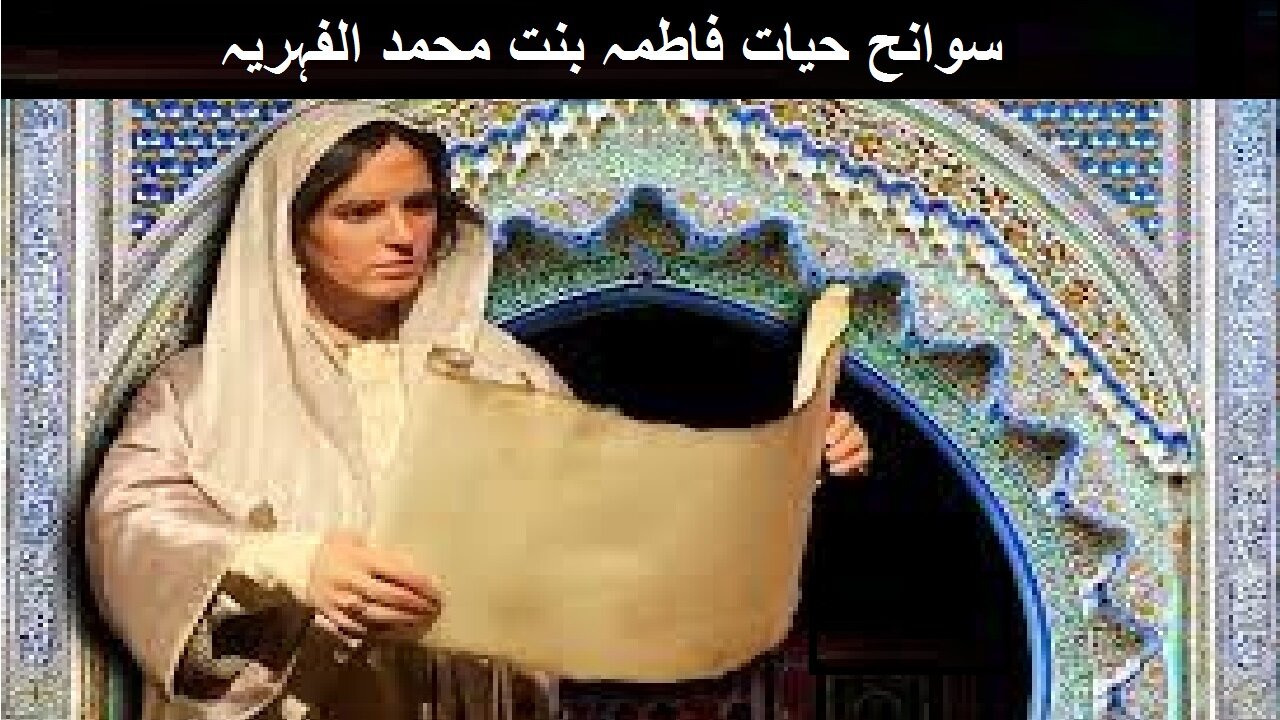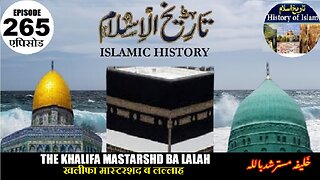Premium Only Content

Biography Fatima bint Muhammad al Fihriya, Morocooian سوانح حیات فاطمہ بنت محمد الفہریہ مراکش
@islamichistory813 #fatimaal fihriya #qarawiyyin #islamicwomen #oldestuniversity #muslimwomen #womenofislam #historyofislam
#islamicknowledge #islamiceducation #fezmorocco #mosquehistory
#islamiclegacy #goldenageislam #muslimscholar #famouswomen
#islamicworld #rolemodel #muslimhistory #inspiration #heritage
#pioneerwoman #legacyofislam #womenleaders #knowledgeinislam
#education
Biography of Fatima al-Fihriya
Brothers and sisters, Assalamu Alaikum wa Rahmatullahi wa Barakatuh. Welcome once again to our channel, where we revive the forgotten pages of Islamic history and honor the heroes who stood firm against oppression. Today, we begin with a name that shines brightly in the history of Morocoo, a woman who carried the Qur’an in her heart and the courage of a thousand men in her soul. She is Fatima al-Fihriya.
Every Saturday on our this Islamic channel, we dedicated our program to Muslim women warriors — those extraordinary daughters of Islam who proved that the battlefield was not reserved for men alone. From the deserts of Arabia to the mountains of North Africa, women of faith rose whenever the honor of their people and the dignity of Islam were at stake. They remind us that true strength comes from iman, and that courage knows no gender.
In the heart of the ancient city of Fez (Morocoo), where the call to prayer echoes between narrow streets and the scent of tradition fills the air, a remarkable story begins. It is the story of a woman whose vision would shape the course of knowledge for centuries to come. Her name was Fatima al-Fihriya, and though she lived more than a thousand years ago, her legacy still shines as a guiding light for seekers of wisdom today.
Born in Kairouan around the year 800, Fatima grew up in a household of faith, learning, and prosperity. When her family migrated to Fez, she carried with her not only the wealth of inheritance but also the wealth of spirit and determination. Unlike many of her time, she did not use her fortune for luxury or personal gain. Instead, she turned her blessings into a gift for the world.
With courage and foresight, Fatima founded the Al Qarawiyyin Mosque in the year 859. What began as a place of worship soon blossomed into a vibrant center of learning, attracting scholars, students, and seekers from across the Islamic world. Over the centuries, this institution would grow into what UNESCO and historians recognize as the world’s oldest continuously operating university.
Fatima al-Fihriya’s name is etched not in stone alone but in the hearts of those who cherish knowledge. She was not just a benefactor, she was a pioneer—an Islamic heroine whose generosity lit the path of education for all humanity.
Fatima bint Muhammad al Fihriya is remembered in history as the woman associated with the founding of the al Qarawiyyin complex in the city of Fez, a foundation that later evolved into one of the most important centres of learning in the medieval Islamic world. She is conventionally dated to the early ninth century and is traditionally described as having been born around the year 800 in the town of Kairouan, in the region now part of Tunisia. Her family, the al Fihri clan, belonged to a migrant community that settled in Fez during the early decades of the ninth century. Her father is reported to have been a successful merchant, and on his death Fatima and her sister Maryam inherited substantial resources that they used for charitable and religious foundations. These biographical details are drawn from medieval Arabic chronicles and the literature of later historians, and while they form the core of the traditional account of her life they are summarized differently in modern studies.
The most enduring part of Fatima al Fihriya’s legacy is her association with the foundation of the Qarawiyyin mosque in Fez. According to the classical narrative recorded by later Moroccan chroniclers, Fatima used the wealth inherited from her father to purchase a prime parcel of land in the city centre and at her direction a mosque was established on that site in the years commonly given as 857 to 859 of the common era. Over time this mosque attracted teachers and students, developed a library, and became the nucleus of an educational institution that in later centuries assumed the functions of a madrasa and eventually came to be recognized as the University of al Qarawiyyin. The mosque and its library were continuously expanded and patronized through generations, and the complex became a major intellectual hub in North Africa, attracting scholars and students of law, theology, grammar, medicine, and astronomy. The continuity of the site as a place of learning is one of the reasons modern authorities identify it as among the oldest continuously operating centres of higher learning in the world.
Fatima’s achievements, and the scale of her impact, are best understood through the concrete accomplishments attributed to her name. She is credited with founding the Qarawiyyin mosque in Fez in 859, an establishment that included a place for congregational prayer, teaching spaces, and a library that ultimately housed an important manuscript collection. The institution associated with the mosque gradually evolved into an organized centre of instruction that issued certifications of mastery in religious and legal sciences. Modern organizations and records recognize the long continuity of al Qarawiyyin’s educational function. UNESCO and other international record keepers have cited al Qarawiyyin in discussions of the earliest continuously operating institutions of higher learning, and the library attached to the complex has attracted international attention, undergoing careful restoration in the modern period to preserve its manuscripts and architecture. The survival of manuscripts and the repeated repairs and restorations to the mosque and library across centuries show an enduring institutional presence in the urban life of Fez. At the same time, historians warn that the story of Fatima is drawn mainly from sources composed several centuries after the events they describe, and that some details of the narrative are difficult to corroborate with contemporary documentary evidence. The medieval chronicle Rawd al Qirtas attributes the foundation to Fatima, and modern scholarship balances respect for local tradition with critical examination of the sources.
Scholars and cultural historians emphasize two complementary truths about Fatima al Fihriya. On the one hand there is an enduring popular and institutional memory that celebrates a woman of means who endowed a mosque school and whose name is tied to an institution that preserved learning for centuries. On the other hand critical historians note that the detailed life narrative is not well attested in contemporary ninth century documents and that many of the fuller stories about her life and actions come from later medieval chronicles. This does not negate the significance of the Qarawiyyin complex as a living centre of learning, but it does recommend care in how the biographical details are presented in a scholarly context. Modern historians therefore tend to describe Fatima as the traditional founder of the Qarawiyyin foundation while also indicating the documentary limitations around precise dates and actions.
Concerning the end of her life, traditional sources place Fatima’s death toward the end of the ninth century. A commonly cited approximate date is around the year 880 in the city of Fez. Exact birth and death dates remain uncertain and are typically given as circa dates in the absence of contemporary registries. Fez, by then an established and expanding urban centre, remained the locus of the charitable and scholarly foundations that she and her family had helped to establish.
The question of Fatima’s burial place and the existence of a distinct shrine is more complicated. There is no reliably attested, widely accepted tomb site that is documented in the same detail as the Qarawiyyin complex itself. Local tradition and modern guides to the city of Fez focus attention chiefly on the mosque, its library, and the surrounding medina rather than on a separate funerary monument bearing her name. In other words, while she is commemorated through the living institution she helped to found, there is not an extensively documented shrine that functions as a major place of pilgrimage specifically dedicated to her in the way that some saints and rulers have been venerated. The historical sources therefore offer a strong institutional memorial through the Qarawiyyin site itself and a more circumspect record about a private tomb or widely acknowledged mausoleum.
Fatima al Fihriya’s legacy lives on in multiple registers. For the people of Fez and for many communities in the wider Muslim world she represents an inspiring example of female patronage of religious and educational life. For historians she is a focal figure through which to explore the growth of urban scholarship in North Africa, the patronage role of wealthy families, and the complex ways that local memory and medieval chronicle writing shape what later generations understand as foundational history. Whether described as the literal founder or the symbolic benefactor, Fatima’s name remains inseparable from the Qarawiyyin complex and from the story of how institutions of learning were funded and sustained in the medieval Islamic West.
As we reflect on the life of Fatima al-Fihriya, we are reminded that true greatness is not measured by wealth, power, or fame, but by the impact we leave on humanity. In an age when opportunities for women were often limited, Fatima broke barriers with her faith, vision, and devotion to knowledge. She planted a seed in Fez that grew into a tree of wisdom whose shade continues to shelter the world even today.
The University of al Qarawiyyin, born from her generosity, remains a living symbol of her dream—where seekers of truth, young and old, can drink from the fountain of learning. Her legacy whispers a message to every generation: that education is a light, and whoever invests in it spreads guidance across centuries.
So let us remember her not only as the founder of the oldest university, but as a shining example of Islamic values—charity, dedication, and service to humanity. May her story inspire us to use our blessings wisely, to build institutions of goodness, and to become torchbearers of knowledge in our own time.
Indeed, Fatima al-Fihriya’s gift to the world was not just a building—it was a timeless vision that knowledge must never die.
With this, we ask for your permission until tomorrow and tomorrow we will narrate biography of . we will also narrate the history of her shrine. Finally, we pray to Allah Almighty to grant us the ability to act on the Quran and Hadith, Amen.
Allah Hafiz
==================================
-
 16:20
16:20
ISLAMIC HISTORY
9 hours agoIslamic History Episode 265 Khalifa Mastarshd Ba lalah खलीफा मास्टरशद ब लल्लाह خلیفہ مستر شد با اللہ
2 -
 9:54
9:54
Dr. Nick Zyrowski
1 day agoDoctors Got It Wrong! What High Cholesterol REALLY Means...
14.5K3 -
 LIVE
LIVE
Tundra Tactical
2 hours agoProfessional Gun Nerd Plays Battlefield 6
135 watching -
 1:06:06
1:06:06
vivafrei
5 hours agoAnother Illegal Alien Kills Americans! Candace Owens Promises to Violate Kirk Gag Order? & MORE!
120K34 -
 1:42:30
1:42:30
The Quartering
5 hours agoTrump Blamed For NBA Rigging Scandal, Major X Change Renders Site Useless, Church Nonsense
149K47 -
 4:18:11
4:18:11
MattMorseTV
7 hours ago $51.62 earned🔴Trump makes URGENT ANNOUNCEMENT.🔴
93.9K91 -
 12:05
12:05
Clintonjaws
10 hours ago $10.23 earnedPortland ICE Rioters Getting Arrested - This Is Priceless!
53K27 -
 LIVE
LIVE
Side Scrollers Podcast
7 hours ago🔴FIRST EVER RUMBLE SUB-A-THON🔴DAY 4🔴WAKE YOUR ASS UP!
946 watching -
 1:25:07
1:25:07
World2Briggs
3 hours ago $0.21 earnedWhere should you live? Ask me Live
8.46K1 -
 LIVE
LIVE
LFA TV
20 hours agoLIVE & BREAKING NEWS! | THURSDAY 10/23/25
801 watching